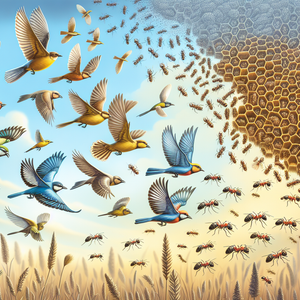The Hidden Symphony of Flavor Pairings

At the core of flavor pairing lies the science of taste, a complex interaction influenced by various factors, including the chemistry of the ingredients, the sensory perceptions of the consumer, and even cultural preferences. The concept of “flavor affinity” suggests that certain flavors work well together due to shared aromatic compounds. For instance, the seemingly unconventional pairing of strawberries and basil may not only surprise the palate but also create a harmonious blend when combined, as both contain similar aromatic compounds. Food scientists and chemists have extensively studied flavors, categorizing them into families based on their molecular makeup. Understanding these families allows chefs to create innovative dishes that surprise and delight the palate. An excellent example of this is the umami-rich flavors of mushrooms and aged cheeses, which can complement the sweetness of caramelized onions, resulting in a complex depth of flavor that captivates diners. The intersection of science and culinary creativity opens the door to an endless array of flavor possibilities.
Cultural Significance of Flavor Pairings
Flavor pairings are not only a product of scientific analysis but also deeply rooted in cultural traditions. Each cuisine offers its unique flavor profiles, shaped by geography, history, and local ingredients. Take Indian cuisine, for instance; the use of spices is not random but reflects centuries of culinary evolution and regional availability. The careful balance of spices creates dishes that tell stories of the land and its people. Consider the classic Italian combination of prosciutto and melon. This pairing is a celebration of contrasting flavors—salty and sweet—that is quintessentially Italian. It showcases how cultural practices influence our taste preferences and how certain ingredients have become synonymous with specific regions and traditions. Chefs who understand these cultural nuances can create dishes that resonate on a deeper level with their audience, inviting diners to experience a taste of history.
Innovative Chefs Redefining Flavor Boundaries
Several chefs around the world are known for their ability to experiment with flavor pairings, challenging traditional notions of taste. One such chef is Grant Achatz, the mastermind behind the renowned Alinea restaurant in Chicago. Achatz employs a variety of techniques to create unexpected flavor combinations, such as pairing beets with chocolate and serving them in a visually stunning, deconstructed format that engages all the senses. His approach redefines what a meal can be, transforming it into a multi-sensory experience that excites and intrigues. Another notable figure is José Andrés, who seamlessly blends Spanish and American ingredients to create dishes that tell a story. His innovative approach to pairing flavors not only enhances the culinary experience but also highlights the cultural connections between different cuisines. Andrés’s work exemplifies how food can serve as a bridge between cultures, fostering understanding and appreciation through shared culinary experiences. Home cooks are also embracing the art of flavor pairing, inspired by chefs and culinary trends. Social media platforms have become vibrant hubs for culinary enthusiasts to share their creative combinations, showcasing the versatility of ingredients. For instance, the combination of peanut butter and sriracha has gained popularity for its balance of creamy, nutty richness and spicy heat, demonstrating that anyone can experiment with flavors in their kitchen. These interactions foster a sense of community and a spirit of culinary exploration that extends beyond restaurant walls.
The hidden symphony of flavor pairings is a captivating journey that combines science, culture, and creativity. By understanding the chemistry of taste and the cultural significance of various ingredients, we can appreciate the artistry behind each dish. The innovative chefs who dare to explore unexpected combinations inspire us to embrace our own culinary adventures. As we continue to discover and experiment with flavor pairings, we not only enhance our meals but also celebrate the rich tapestry of global cuisine. This journey reminds us that food is not just about sustenance; it is an experience that connects us all, weaving together stories, traditions, and tastes from around the world. Whether in a fine dining restaurant or a cozy kitchen, the symphony of flavors awaits, ready to be explored and enjoyed.
Flavor Scientist
Firmenich, Givaudan, IFF
Core Responsibilities
Conduct research on flavor compounds and their interactions to develop new flavor profiles for food products.
Collaborate with chefs and food technologists to innovate and improve recipes based on scientific findings.
Perform sensory evaluations to assess consumer preferences and product quality.
Required Skills
Strong background in food science or chemistry, with a focus on flavor chemistry.
Proficient in sensory analysis techniques and statistical analysis software.
Creative problem-solving skills to experiment with and refine flavor formulations.
Culinary Development Chef
Nestlé, Unilever, General Mills
Core Responsibilities
Create and test new recipes that highlight innovative flavor pairings and culinary techniques.
Work closely with marketing teams to align product development with consumer trends and preferences.
Train kitchen staff on new cooking techniques and flavor pairing concepts.
Required Skills
Culinary degree with several years of experience in a high-end restaurant or food product development.
Expertise in flavor pairing principles and the ability to think outside traditional culinary boundaries.
Strong communication and teamwork skills to collaborate effectively with cross-functional teams.
Food Stylist
Food magazines, advertising agencies, culinary schools
Core Responsibilities
Design and arrange food presentations to enhance visual appeal for photography, commercials, and publications.
Collaborate with chefs and photographers to select ingredients and styles that complement the intended message.
Stay updated on current food trends to create visually stunning and culturally relevant presentations.
Required Skills
Strong artistic sense with experience in food preparation and plating techniques.
Excellent eye for detail and an understanding of color theory and composition.
Ability to work under tight deadlines and adapt to the demands of various projects.
Culinary Food Scientist
Kraft Heinz, PepsiCo, Mars, Inc.
Core Responsibilities
Develop and improve food products by applying culinary techniques and scientific principles.
Conduct experiments to analyze texture, flavor, and nutritional content of food items.
Collaborate with cross-disciplinary teams to ensure product feasibility and compliance with regulations.
Required Skills
Degree in food science, culinary arts, or related fields with experience in product development.
Knowledge of food preservation methods and food safety standards.
Strong analytical skills and the ability to conduct detailed research.
Culinary Marketing Specialist
Blue Apron, HelloFresh, various food startups
Core Responsibilities
Develop marketing campaigns that highlight innovative flavor pairings and culinary trends for food products.
Conduct market research to identify consumer interests in flavor profiles and culinary experiences.
Collaborate with chefs and influencers to create engaging content that showcases products.
Required Skills
Background in marketing, communications, or culinary arts with a passion for food trends.
Strong writing and storytelling skills to convey the culinary narrative effectively.
Familiarity with social media marketing and digital content creation.


